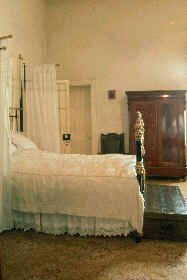| Inside the house |
|
Mrs Kruger's reception room

|
In the corner where Gezina did her sewing is a special table that contained her sewing necessities. A needlework box with the Colosseum on the lid which was presented to the museum by Gezina's granddaughter can also be seen. |
|
President's reception room

|
The President received a constant flow of visitors in this room so the double suite of furniture is not superfluous. The room contains many important pieces, such as:
the table at which many famous people had talks during the years, for example John X Merriman, Cecil John Rhodes, M T Steyn, Henry Stanley, Mark Twain and many others
the satuettes presented to Kruger by the scholars of the schools in Charlemagne, France
a bronze-gilded eagle: given after the failure of the Jameson raid by a group of Irish-Americans (from Chicago) under Colonel Blake
the indispensable spittoons
the harmonium used by the family during their devotions
the wrought-iron heater
the oil painting of Kruger by Adamson
|
| Offices |
There are two rooms at the western end of the passage. The President retired to the inner room when he was in need of meditation. The front room was mostly used by the secretary. It contains one of the first telephones to be installed in Pretoria in 1891. |
|
Main bedroom

|
The large wardrobe was originally used in the house by the Krugers. A kist in front of bed contained some of President's personal effects. |
| Other bedrooms |
Used by children and grandchildren when visiting, as well as other guests. |
|
Dining room

|
Little is left of the original furniture but the room has been re-furnished in the same way in which is was in Kruger's day. It contains:
The official dinner service in a cabinet.
a photograph of John George Bender, First Lieutenant in the Mounted Guard of Honour.
The French doors lead to the back verandah and kitchen from where meals were served.
|
| Pantry |
The pantry has been furnished with utensils typical of the period, e.g. a sieve netting cupboard, plates, dishes, moulds, etc |
